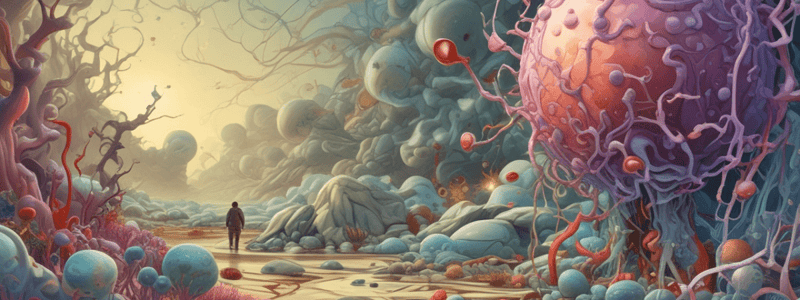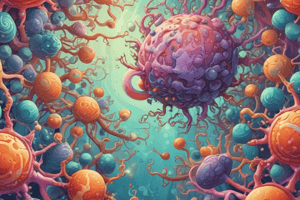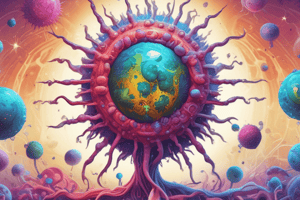Podcast
Questions and Answers
What is the definition of an infectious disease?
What is the definition of an infectious disease?
- When the normal flora is depleted by antibiotic therapy
- When the host's immune system succeeds in eliminating the pathogen
- When the host's immune system is compromised
- When the pathogen succeeds in evading and/or overwhelming the host's immune defences (correct)
Which of the following is NOT a factor that can lead to clinical problems?
Which of the following is NOT a factor that can lead to clinical problems?
- Overgrowth of normal flora due to immune-compromised host
- Vaccination (correct)
- Breaching of skin integrity
- Displacement of normal flora from its normal location to a sterile location
What is the term for the cells and organs that contribute to immune defences against infectious and non-infectious conditions?
What is the term for the cells and organs that contribute to immune defences against infectious and non-infectious conditions?
- Normal flora
- Pathogen
- Innate barriers
- Immune system (correct)
Which of the following is an example of a normal flora that can become pathogenic?
Which of the following is an example of a normal flora that can become pathogenic?
What happens when the normal flora is depleted by antibiotic therapy?
What happens when the normal flora is depleted by antibiotic therapy?
Which of the following is a high-risk patient group that is more susceptible to serious infections?
Which of the following is a high-risk patient group that is more susceptible to serious infections?
What is the term for the initial response that occurs when the pathogen overcomes the innate barriers and enters the body?
What is the term for the initial response that occurs when the pathogen overcomes the innate barriers and enters the body?
Which of the following is an example of breaching the skin integrity?
Which of the following is an example of breaching the skin integrity?
Which of the following complement proteins is NOT initiated by antibody-antigen?
Which of the following complement proteins is NOT initiated by antibody-antigen?
What is the primary function of opsonins such as C3 and C4?
What is the primary function of opsonins such as C3 and C4?
Which of the following is NOT an example of an acute phase protein?
Which of the following is NOT an example of an acute phase protein?
What is the primary mechanism by which the complement system contributes to the clearance of pathogens?
What is the primary mechanism by which the complement system contributes to the clearance of pathogens?
Which of the following pathways is initiated by cell surface microbial constituents, such as endotoxins on E. coli?
Which of the following pathways is initiated by cell surface microbial constituents, such as endotoxins on E. coli?
What is the primary function of Fc receptors on phagocytes such as macrophages and neutrophils?
What is the primary function of Fc receptors on phagocytes such as macrophages and neutrophils?
What is the primary function of pattern recognition receptors (PRRs) on macrophages?
What is the primary function of pattern recognition receptors (PRRs) on macrophages?
Which of the following cytokines is responsible for neutrophil recruitment in blood vessels?
Which of the following cytokines is responsible for neutrophil recruitment in blood vessels?
What is the result of mast cell degranulation during inflammation?
What is the result of mast cell degranulation during inflammation?
Which of the following is NOT a local inflammatory action of cytokines?
Which of the following is NOT a local inflammatory action of cytokines?
What is the role of C-reactive protein (CRP) in the immune response?
What is the role of C-reactive protein (CRP) in the immune response?
Which of the following cells is responsible for presenting antigens to T and B cells, initiating the specific adaptive immune response?
Which of the following cells is responsible for presenting antigens to T and B cells, initiating the specific adaptive immune response?
What is the result of cytokine-mediated inflammation in blood vessels?
What is the result of cytokine-mediated inflammation in blood vessels?
Which of the following pathways is activated by the presence of pathogens in the immune response?
Which of the following pathways is activated by the presence of pathogens in the immune response?
What is the primary mechanism by which macrophages destroy pathogens?
What is the primary mechanism by which macrophages destroy pathogens?
What is the result of decreased phagocytosis in asplenic patients?
What is the result of decreased phagocytosis in asplenic patients?
Which of the following is an example of an oxygen-independent pathway?
Which of the following is an example of an oxygen-independent pathway?
What is the primary function of NETs?
What is the primary function of NETs?
What is the result of decreased neutrophil number?
What is the result of decreased neutrophil number?
What is the process by which neutrophils externally trap pathogens?
What is the process by which neutrophils externally trap pathogens?
Study Notes
Immune System and Infectious Disease
- The immune system consists of cells and organs that contribute to immune defenses against infectious and non-infectious conditions, distinguishing between self and non-self.
- Infectious disease occurs when a pathogen succeeds in evading and/or overwhelming the host's immune defenses.
Innate Barriers
- Innate barriers include microbiota (commensals) that live on the skin and in the nasopharynx, such as Staphylococcus aureus, Streptococcus pneumoniae, and Candida albicans.
- These microorganisms can become pathogenic under certain conditions.
Clinical Problems
- Clinical problems arise when:
- Normal flora is displaced from its normal location to a sterile location.
- The skin integrity is breached, e.g., through skin loss, IV lines, surgery, skin diseases, or injection drug use.
- The fecal-oral route or fecal-perineal-urethral route is compromised, leading to infections such as foodborne infections or urinary tract infections.
- There is poor dental hygiene or dental work, resulting in infections such as dental extraction or gingivitis.
- Patients are at high risk, e.g., asplenic or hyposplenic patients, or those with damaged or prosthetic valves.
The Immune Response
- The initial immune response occurs when a pathogen overcomes the innate barriers and enters the body.
- Macrophages recognize pathogen-associated molecular patterns (PAMPs) and phagocytose them, releasing cytokines that recruit other cells to the site of infection.
- Cytokines also cause inflammation, leading to vasodilation, vascular permeability, mast cell degranulation, and clotting system activation.
Microbes and PAMPs
- Microbes have PAMPs that interact with pattern recognition receptors (PRRs) on innate cells.
- This interaction leads to the activation of macrophages, monocytes, and neutrophils, which release cytokines such as TNF alpha, IL-1, IL-6, and IL-8.
Phagocytosis and Opsonins
- Phagocytosis is the process by which phagocytes (e.g., macrophages and neutrophils) internalize and destroy pathogens.
- Opsonins, such as complement proteins, antibodies, and acute phase proteins, enhance phagocytosis by marking pathogens for destruction.
- Examples of opsonins include C3, C4, IgG, IgM, CRP, and MBL.
Clearance of Opsonized Pathogen
- Complement proteins can "punch holes" in the pathogen's cell membrane, leading to death.
- Phagocytes recognize opsonized pathogens through Fc receptors, internalize them, and produce reactive oxygen species to destroy the pathogen.
Phagocyte Intracellular Killing Mechanisms
- Oxygen-dependent pathway: respiratory burst produces toxic oxygen products (e.g., hydrogen peroxide, hydroxyl radical) that kill pathogens.
- Oxygen-independent pathways: lysozyme, lactoferrin or transferrin, cationic proteins, proteolytic and hydrolytic enzymes, and NETs (neutrophil extracellular traps).
NETosis
- NETosis is the process by which neutrophils externally trap pathogens using decondensed chromatin and granule contents.
- This mechanism can be used as a means of neutrophil cell death and is commonly used to deal with pathogenic insults.
Summary of the Innate Immune Response
- The innate immune response is a crucial defense against pathogens, involving the recognition of PAMPs, activation of macrophages and neutrophils, and the production of cytokines and opsonins.
- Phagocytosis and intracellular killing mechanisms are essential for eliminating pathogens.
Studying That Suits You
Use AI to generate personalized quizzes and flashcards to suit your learning preferences.
Related Documents
Description
Understand the key factors that determine the outcome of a host-pathogen relationship, including the immune system's role in defending against infectious and non-infectious conditions. Learn about the innate barriers and microbiota's role in the immune response.



